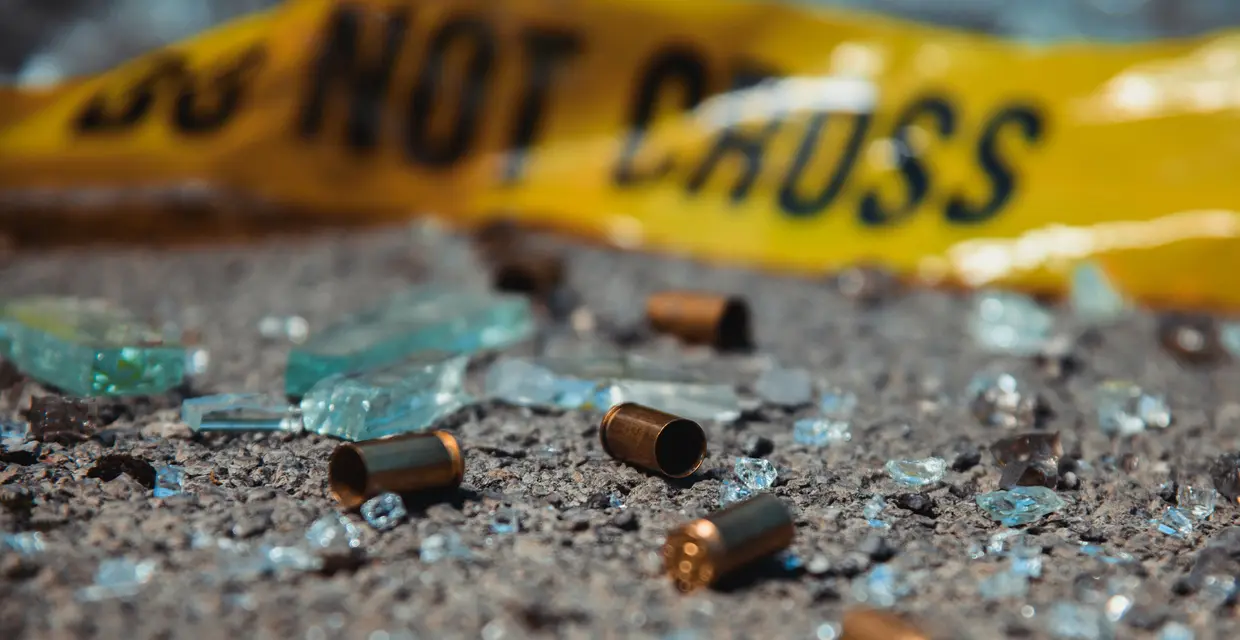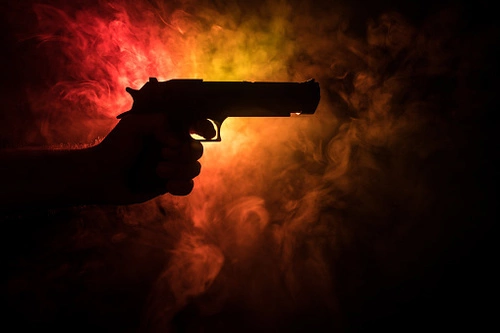1. Select a discrete app icon.

notes
Gunned Down by An Abuser, Part 2
Janet Paulsen got police to take away all of her abusive husband’s guns … except one
- Jun 21, 2022

Janet Paulsen speaks out for the same reason April Ross (featured in this story) does: She doesn’t want anyone else to wind up paralyzed or worse because their abusive partner got a gun and decided to use it against the person they once promised to love.
But not everyone gets it. Like the man who confronted Paulsen at a bar. A stranger who came up to Paulsen and slapped his hand down on her shoulder—another man who felt entitled to touch her body without permission and question her choices.
Why do women stay in that shit? he asked her. You stayed, so you get what you get, right?
She responds with, “It took me five years to get up the courage to leave. And you know what happened when I did? He shot me six times. That’s why we don’t leave. We’re being threatened, bullied, controlled and sexually assaulted.”
An Escalating Threat
It was hard, at first, for Paulsen to accept she was a victim of domestic violence. She and ex-husband Scott Bland had a seemingly perfect love story—meeting in 1995 after being set up on a blind date. Engaged four years later. Twin boys born in 2002. Bland was a doting, hands-on father when he wasn’t working as an electrician. He changed diapers, took his sons to daycare when Paulsen had the longer commute to her job in marketing. As they got older, Bland coached the boys' youth baseball team.
But in hindsight, says Paulsen, there were signs. A gradual escalation of an abusive husband.
“He didn’t physically abuse me, but he could be flat-out mean,” she says. “He was sexually abusive. Controlling. Now that I look back on it, I can piece it together.”
Throughout the two decades they were together—15 of those spent married—he became more verbally abusive toward his wife as well as his sons. And he became even more dangerous when he was drinking. One day, Paulsen got a call from another parent whose son played football with her boys, who were 13 years old at the time.
Does Scott have a drinking problem?
“I thought, oh lord, what has he done now?,” Paulsen remembers. “I confronted him.”
He told her to tell the other parents to “mind their own f**king business.”
A week later, her boys would disclose what really happened after football practice. Bland would drive to a gas station, buy four or five large beers and park in a nearby cemetery to drink them, the boys in the back seat. He’d crush the cans and put them in the center console of the car before driving his children home, drunk.
She begged him to get help, to see a therapist, to stop drinking. He wasn’t open to her suggestions, but instead, became more volatile.
In 2015, Paulsen had had enough. She wanted a divorce. She told her husband they were going to separate and Bland threatened her.
Try to go upstairs and get the boys and see what happens to you, he hissed.
Eventually, he stormed out of the house, called Paulsen’s dad and shared his plans.
If she thinks she’s going to leave, I’m going to kill her.
Paulsen filed for a divorce and an order of protection. For the last two years, she’d been creating what she called a divorce file, making photocopies of important documents and secretly taking photos of the firearms her husband kept in the basement of the house. She’d counted 74 in total.
Most of the guns were locked in gun safes, but Paulsen said she found out later he also always kept one on him, strapped to his leg. He also had one in his desk drawer in the office and one in the glove compartment of his truck. She let police know where every gun was.
When the temporary protection order was granted, Bland wasn’t allowed within 1,000 feet of his home, his wife or the boys. Police came to confiscate his guns while Paulsen waited at the police station. An officer told her they got all the guns. Except for one. Police told her they couldn’t take away the gun he kept in his truck.
“Well, it’s kind of a grey area,” an officer told her. The truck was on her property— the officer got the garage door opener from him, but let him leave with the gun in his truck.
Five days later, on November 5, 2015, Bland would return to Paulsen’s home and shoot her six times with the gun police didn’t take.
The Day Everything Changed
Paulsen thought she was safe at the time. She had gotten the protective order, filed multiple police reports, changed the locks on the house and her parents were staying with her. But hindsight is always 20/20.
“Looking back on it, I think, of course he was going to shoot me.”
The next day, after his guns were confiscated, Paulsen found out that Bland had activated a tracking app on her and her son’s phones, a clear violation of the protective order. She immediately went to the police department to file a report. If found guilty of the violation, Bland could spend three weeks in jail, says Paulsen.
But the judge looked at it differently.
Well, we don’t necessarily know he did that. Someone else could have had control of the phone, she remembers being told. They didn’t arrest him but put out a warrant for his arrest for a misdemeanor charge. It was a Saturday.
On Monday morning, he put down a retainer with a divorce lawyer, prearranged for bail and turned himself in at 6 p.m. Paulsen says he was out by 8 p.m.
On Thursday, Nov. 5, on the advice from police, Paulsen applied for a concealed-carry permit. She was afraid for her life. Then, she stopped at her attorney’s office to sign her divorce papers before running some errands and going grocery shopping.
Meanwhile, Bland had driven to her neighborhood, parked his car about a mile away from his former home so as not to garner any unwanted attention, walked through a wooded area to the house and hid in wait for his family to arrive home. He was dressed all in black with his gun strapped to him, an extra box of ammunition at the ready. Paulsen is certain he was planning to kill both her, her father and their children when they arrived home from the boys’ football practice, but fate intervened.
Paulsen had to run home early from the boys’ football practice. The groceries she had bought needed to be refrigerated. Her dad would bring his grandsons home later. The decision would end up saving their lives.
She pulled her car into the garage and pressed the button to close the door, but as it began to close, she heard an ominous sound. Someone kicked it back up. She looked in her side mirror and saw her ex-husband inside her garage. She heard the sound of a gun cocking and the garage door beginning to go back down. A voice inside her head told her to get out of the garage or she’d be dead.
She threw the car in reverse, ducked her head into her lap and slammed her foot down on the gas, busting through the garage door. Her car kept going across the street until it collided with a tree, exploding her back windshield. She looked up to see Bland walking down her driveway pointing the gun directly at her.
“Again that voice told me, Get away from this tree, go forward, reverse back into the street! You’ve got to get out of here! I was so hysterical, I hit the gas too hard…I careened back over the side of my driveway and crashed into the trees and woods on the side of my house.”
Her car was lying at an angle. She saw him coming toward her through her window.
She managed to get the passenger side door open and began running through the woods, screaming.
“And then I heard, pop, pop, pop. I felt stinging in my abdomen and I knew I’d been shot. And I knew I wasn’t going to make it through the woods.”
Paulsen turned back and began to run toward her neighbor’s house. That’s when Bland shot her again, in the leg this time. She fell over in the middle of her driveway and watched as he walked menacingly closer. He shot her twice more—she knew the last shot had hit her vertebrae.
“I felt this electric jolt go through my body and I couldn’t move my legs. I remember calling out, I’m paralyzed. …But I remember telling myself, hey, you’re OK. If that’s the worst thing to happen, you can live in a wheelchair. It’s OK. You just stay awake.”
She lay on the ground in disbelief. "This isn’t happening. You were so close to getting away out of this madness," she thought.
“People say their life flashed before them, but it was my future that was flashing before my eyes," she says. "Raising my boys and seeing my boys grow up and having peace. That’s what I saw.”
She told herself to fight for her life as Bland walked even closer, looming over her. She held up her hands to block her face and turned away from him.
Don’t shoot me any more, I’m dying, she told him.
He looked down at her and said, Watch this. She looked up to see him put the gun to his own head, cock it and pull the trigger, but it only clicked. He had fired all the ammunition in the magazine at Paulsen.
She watched him run away as the sound of sirens got closer. Her neighbors had called the police. They were shouting, Stop firing!
There was going to be one more shot: Bland had gotten more ammunition. Initially, he walked back toward Paulsen as she frantically began to pray that he wouldn’t shoot her again.
“For whatever reason—maybe he thought I was dead—but he laid down on the grass behind my car and shot himself once in the chest. I saw his legs kick up.” The next thing she remembers is the police standing over her asking her who shot her.
Scott shot me, she said over and over. More officers kept asking her. She kept saying her husband’s name.
“I found out later the reason they kept asking me was that I didn’t make it. As more officers arrived, more than one could testify that he did it.”
She remembers every excruciating moment of the drive to the hospital, willing herself to stay awake, to stay alive, as paramedics called out to her, 10 more minutes, five more minutes, we’re here, Janet. And then it goes black.
She would find out later she was DOA, or dead on arrival, to the trauma bay. A trauma surgeon performed heroic measures to get her heart beating again. Much later, when Paulsen was in the midst of her recovery, some of the medical team visited her and described what the surgeon had done that day, basically cracking open her rib cage to shock her heart from the inside before using his hand to manually start it beating again. We’ve seen it done 30 times and it hadn’t worked once, they told her incredibly. We’ve never seen anyone as critical as you make it.
A year later her trauma surgeon told her she was the one percent. She didn’t know what he meant. When she asked, he explained that out of 100 times he performs that procedure on a DOA trauma patient, it works once. Paulsen felt an overwhelming sense of fright and humbleness mixed together. What if they hadn’t tried? What if the medical team thought she was too far gone? She says she thought about 100 people standing in a circle holding hands, looking at each other, asking who is going to be the one?
It was me, Paulsen thought. That’s when she knew she had to pay it forward.
A Long Road Forward
Paulsen spent three-and-a-half weeks in a coma and then nearly another month in the hospital before being transferred to the Shepherd Center where it took another two-and-a-half months to begin to learn how to navigate her new life. As she had initially suspected, Bland’s last shot had paralyzed one quadrant of her body—from her right hip to her right toe. After four years of intensive physical therapy, she regained about 40 percent of the muscle in her right leg. She can walk short distances using crutches but mainly relies on a wheelchair. Still, it hasn’t gotten her down the way some might think it would.
“A lot of people [at the Shepherd Center] were there because of an accident—a car accident or they fell off the roof—and I remember being in these therapy sessions and people were crying asking, how did this happen to me? But I never felt like that. I always felt like, this is awesome. I’ll take it! Because I’m alive. I’ll take this wheelchair. I’m a badass in it.”
Bland died from his injuries. Paulsen’s sons chose not to attend the funeral. He’s not our dad, they would tell Paulsen’s parents. Her parents, who helped care for the boys while Paulsen was recovering, asked the boys to write their future selves a letter in case they ever wondered why they didn’t attend their dad’s funeral. They read the letters to their grandparents.
“Basically, they said, ‘You said you would never hurt us and you hurt our mom so you’re not our dad anymore,’” Paulsen remembers her parents telling her. The boys also asked their grandfather if they could change their last names. They wanted to be Paulsens.
As for Paulsen, she has her own theory on how she could survive six gunshots and he died after one.
“He didn’t make it because, in the end, I was stronger than he was.”
Donate and change a life
Your support gives hope and help to victims of domestic violence every day.
Enacting Change
While Paulsen was at the Shepherd Center, she rolled past the gift shop window one day. There were two plaques that she felt compelled to get, which now hang in her kitchen. The first one says, “You never know how strong you are until strong is all you have left.” The other reads, “Someday this will all make sense.” Advocating is what makes sense to her now, she says.
One might think Paulsen is anti-firearm after this experience, but it’s quite the opposite.
“I have a gun. I don’t want anyone taking it away.”
Instead, she works to advocate for safer gun laws, like overturning Georgia’s decision to not comply with the Lautenberg Amendment that would prevent anyone convicted of a misdemeanor domestic violence crime to possess a firearm, something that could have prevented her ex from keeping that one final gun.
"I know this is a weird way to say this, but it’s a lot more work to stab somebody. If we can eliminate one of these in a safe and logical way, let’s do that," says Paulsen.
She’s also using her experiences to help shape a new Family Advocacy Center in Cobb County, Georgia, a one-stop shop for victims of abuse and assault to find help.
“All your services are in one place so you don’t have to go from the police department to the court house back to the police department. All the nonprofits are there, all the judges are there via telecom, the police are there, counselors are there, the rape kits are done there and processed there. It’s a really good thing. I wish it had been there when I needed it.”
As for her boys, they are 19 now, both on baseball college scholarships. “My greatest accomplishment is that I have not raised future abusers. My boys are good men, sensitive to women’s issues and struggles people with disabilities face.”
Jon Stewart’s Show Reaches Out
And then, of course, producers from Jon Stewart’s show, “The Problem” on AppleTV+ called. They wanted Paulsen and fellow survivor, Ross, to come on the episode titled, “The Problem with Guns.” Paulsen was an immediate yes.
“It was a little scary going on national television but I was honored to be on Jon Stewart’s show. He and the producers did an amazing job of highlighting the issues. April and I knew we would get some backlash, victim-blaming, etcetera. But as Jon wisely said…’never read the comments.’ I would like to thank the Jon Stewart Show for shining some light on domestic violence.”
Looking for someone to speak with? Enter your location to find phone numbers for domestic violence experts in your area.
Have a question about domestic violence? Type your question below to find answers.







